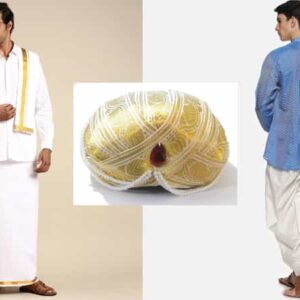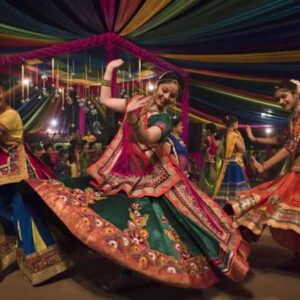Assam, one of the North Eastern states comes with its characteristic scenic beauty and serenity. The verdant green forests and the mist-clad hill slopes of Assam pull tourists from far and wide. Another aspect that defines the state is its deep cultural roots. The culture and traditions that the state is gifted with are mirrored through the costumes that the locals wear. The traditional dresses of Assam speak of a rich cultural heritage handed over to progeny by the ancestors. The natives of the state are doing their best in carrying the flame ahead. Fantastic motifs and mind-blowing threadwork on the rich fabrics make Assamese attires stand out. If you wish to learn more about the traditional dress of Assam, read the article below:
Assamese Men’s Attire
Dhoti & Gamosa
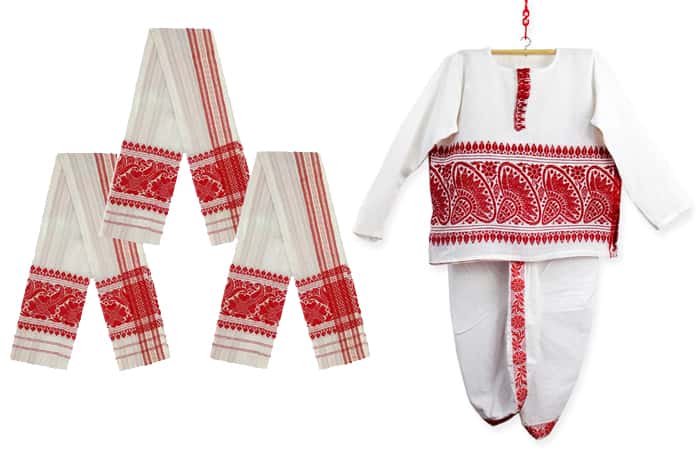
Dhoti and Gamosa go hand in hand to complete the traditional look of an Assamese man. The two jointly represent the indigenous handloom craft of Assam. The dhoti is worn in a typical manner to clad the lower portion of one’s body while the Gamosa is used on the upper body. The dhotis are tied around the waist and are 5 yards in length. Dhoti’s one end is made to pass between a man’s legs and is tucked smartly inside his waistband. We all know about ‘dhotis’ as they make an integral part of the Indian culture while ‘Gamosas’ make a vital part of the Assamese culture. Gamosa is a rectangular white cloth bordered red on its three sides. The fourth side of the Gamosa comes with attractive woven motifs. In Assam, Gamosas stand as a symbol of honor. So, Gamosas are often gifted to people who have achieved something great and laudable. Gamosas are usually crafted out of cotton yarn but those that are used for festive occasions are crafted out of pat silk. In most cases, the Gamosa is hung around one’s neck but occasionally it might be used as a headgear where men tie it around their heads. Also, the Gamosa is versatile enough to be used as Loincloth during Bihu dance or as a waistcoat called Tongali.
Chola
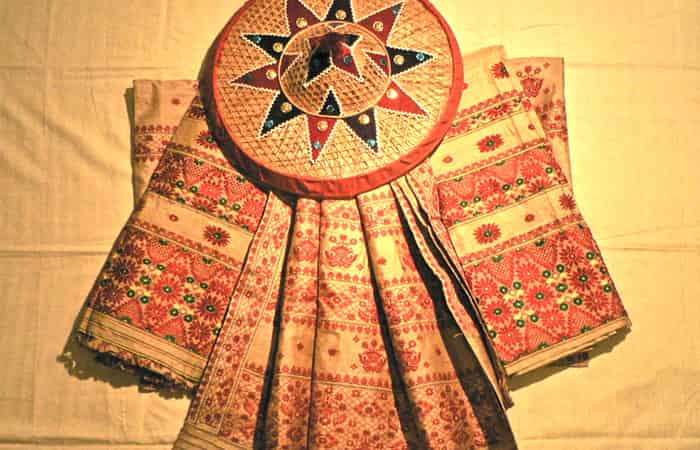
Chola is a kind of shirt that men wear to cover their upper body. Rudra Singha, the king of Assam state was the one who brought in the concept of shirts. During that time the royals and high officials of the state used to wear Cholas of different colors. The Cholas they wore were called Chapkan and Chauga. Swargadeos, the ruling clan of Assam used to wear various kinds of Cholas like Rupar Bridiya, Chengcola, Buku Chola, and Enga Chola to name a few. The locals still hold on to the tradition of wearing Cholas. But, the Cholas you get to see now are styled in accordance with contemporary fashion.
Assamese Women’s Attire
Mekhela Chador/Sador
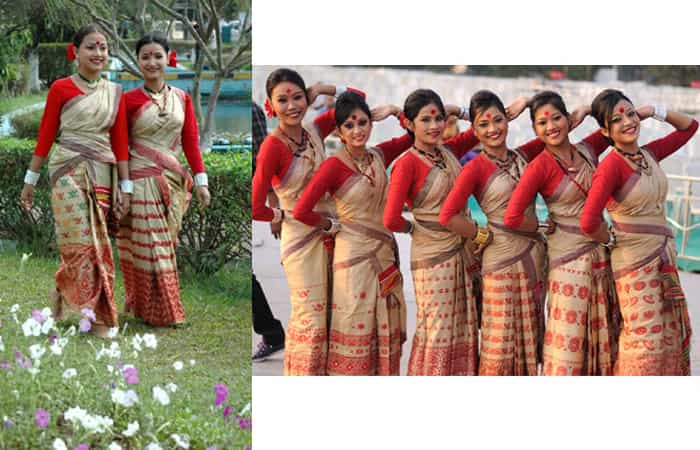
Women of Assam wear the traditional Mekhela Chador on all festive occasions. The garb consists of two cloth pieces-one for the bottom and the other for the upper body. The cloth that is draped to cover the lower body has a cylindrical shape. It is called Mekhela. The Mekhela is draped waist downward and is tucked on the right side of the waist after being folded neatly into crisp pleats. The other piece of cloth is called the Chador/Sador. The chador’s one end is tucked artfully into the upper portion of the Mekhela and another end is used to drape the body’s upper part in a pallu style. This traditional attire apparently looks like a saree but it is actually different. In the recent time, the Mekhela-Chador is paired with a well-fitted blouse. Triangular folds are used to drape the Mekhela-Chador and this is indeed an art that needs to be mastered. Silk is used to craft the Mekhela Chador and there are three major varieties of silk used. Muga silk, Pat silk, and Eri silk are the three varieties of silk used in this attire.
In the past, Riha was used instead of blouse along with the Mekhala Chador. Riha was another piece of unstitched cloth wrapped around the bust. Mekhela-Chador paired with the Riha made the perfect bridal trousseau of an Assamese bride. These days it has been replaced by the blouse.
Sualkuchi, a hamlet nearly 35 kms from the state capital Guwahati is referred to as the Silk Heaven of India as most of the traditional Mekhela Chadors that the state is famous for, are woven here. Artisans residing in this village excel in crafting exceptionally beautiful Mekhela Chadors that are famous worldwide and have a robust global market.
Assam Silk Sarees

High-quality silk sarees embellished with authentic cultural motifs have stood the test of time and trends. These sarees come in a vast array of colors and display gorgeous embroideries. Modern women of the state love to flaunt the splendorous silk-saree party look on all special occasions. Assam silk sarees are in high demand all over the world. If you wish to pick some of the best silk sarees of Assam, visit Silkalay, a prominent shopping hub in Guwahati. Assam Silk Emporium is also another place to buy good quality Assam silk sarees.
Tribal Attires of Assam
The culture of Assam represents an intriguing mix of diverse ethnic groups. The state is inhabited by a wide range of tribes each one coming with its typical unique culture. The costumes they wear speak a tenfold about the distinctiveness of each tribal group. Some of the major tribes of Assam are Dimasa, Bodo, Mishing, and Rabha.
Dimasa Tribe Costume
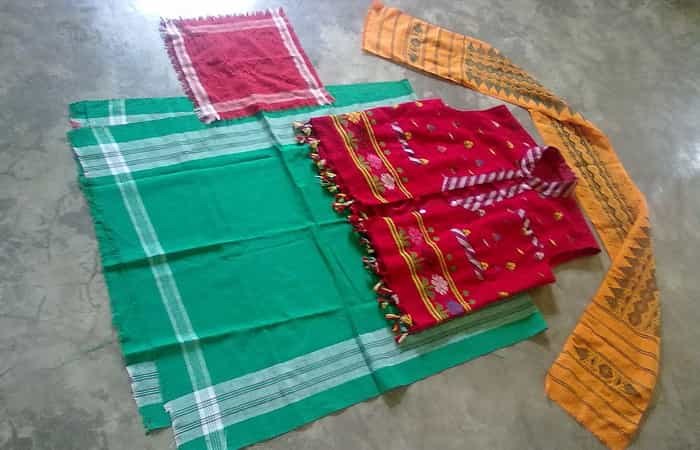
The Dimasa tribe men take pride in wearing the Sgaopha or Pagri. It is actually a status symbol for the men of this tribe. The Sgaopha is usually yellow or green colored but during weddings, it might be white colored adorned with a red colored thread. They also carry the Rigdo, a type of muffler.
Bodo Tribe Costume

Bodo men tie the Gamosa around their waist and allow the ends to drop down to their knees. For the upper body they use shirts and they use Khoroms for their footwear. Decades back the men of this tribe used to keep their upper body bare but with the changing times, they too are wearing shirts. The women wear the Dokhna. It is dress-type clothing wrapped around the body in a typical fashion. The Dokhna starts from one’s chest and extends downward to reach the ankles. This uniquely crafted clothing cannot be wrapped around a woman’s body more than once and therein lies its uniqueness. Rich colors and patterns define this traditional tribal garb. Salamatha is the bridal attire worn by this tribe.
Mishing Tribe Costume
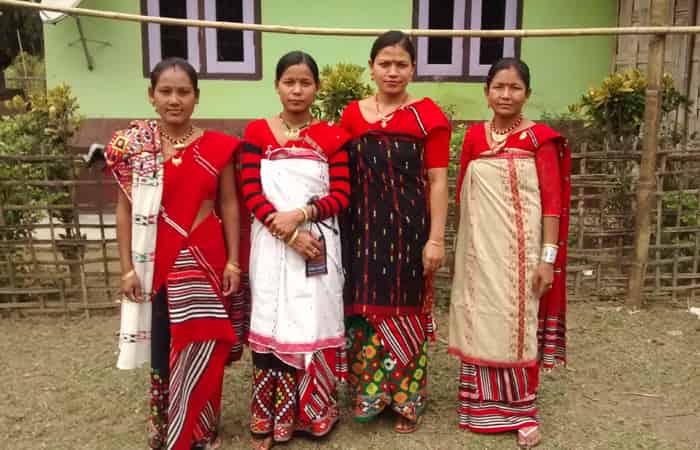
Men of the Mishing tribe wear a dhoti called Gonru Ugon and shirt-type upper-body clothing called Mibu Galuk. They too don’t forget to sport the Gamosa Dumer. Women of this tribe wear a black-hued typical Mekhala Chador known by the name of Yakan Age Gasa’. The blouses they wear are vibrantly colored.
Rabha Tribe Costume

Men of the Rabha tribe follow the typical Assamese dress code of Gamosa and Dhoti but the women exhibit a unique dress sense. The women’s attire comprises of three things- the Koum Kontong (a skirt-styled piece of cloth decked with exquisite motifs), the Kambang (clothing for the upper body), and the Labok (a waistband decked with pearls and shells).
Accessories to Complete the Traditional Look
Paguri
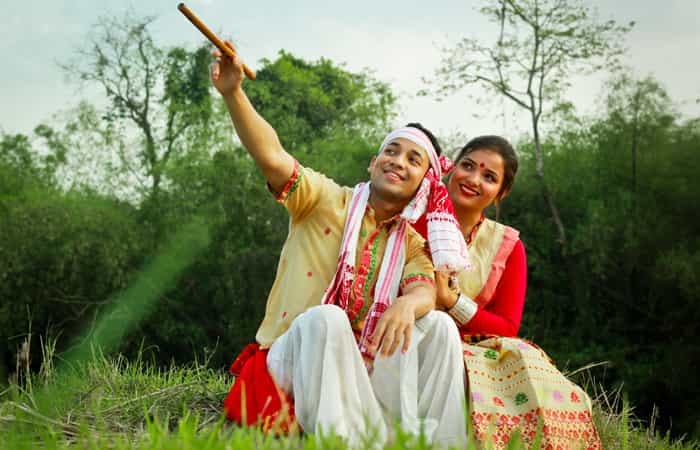
Assamese men often accessorize their costume with a turban called ‘Paguri’. It is a kind of headgear also differently referred to as ‘pag’. During the times of Gadadhar Singha, an Ahom king, Phasau, a turban of quite simple design was introduced. Another king, Rudra Singha, brought in a turban style ‘Jama’ which was similar to the turbans worn by Mughal rulers. In the recent times, the locals of the state wear a simple form of turban but those belonging to higher strata in society cover their heads with special turbans that differ from the simple ones in look and form.
Khorom

This is a kind of wooden footwear worn by the menfolk. It consists of a knobbed post that comes exactly between the second and the big toe. Khoroms can either be absolutely simple or elaborately decked. Teak wood or ebony is mostly used in making these exotic foot wears.
Jewellery

No attire is complete without the use of Jewellery. Women of Assam make sure to deck themselves up with traditional Assamese jewelry on all special occasions. Shells, pearls, vibrantly colored gemstones, and Minakari are generously used in Assamese Jewellery. The jewelry motifs are largely inspired by Mother Nature and consist of things like animals, birds, and musical instruments. Some of the famous neck ornaments of Assam are Gal Pata, Dholbiri, Jonbiri, Loka-Paro, Kerumuni, and Dug-Dugi. Thurayas are traditional earrings worn by the aged Assamese women. Gam-Kharu is a typical bangle bracelet that Assamese women adorn their wrists with.
So, this is all about traditional Assamese dresses. Even if you are not an Assamese, you can flaunt the traditional look of Assam by adorning yourself with these traditional costumes.

